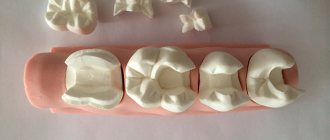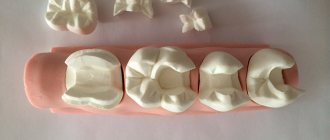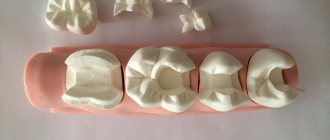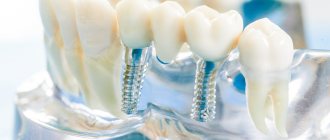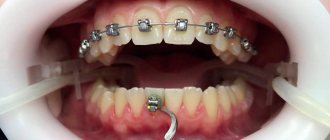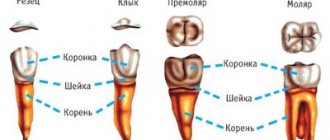Many patients do not know that they can put fillings on their front teeth. Its goal is not only to eliminate defects, but also to restore anatomical, physiological and aesthetic properties.
The procedure is quite popular. In order for the result to please the patient, it is necessary to choose a competent specialist with extensive experience. A professional will select the necessary material individually for each type of teeth and install the product so that it will not be noticeable in the smile area.
Installing a temporary filling
A filling between the front teeth is often placed due to carious lesions. For several days, it protects healthy tissues and nerve endings from external influences.
After a session of cleaning the canals and removing the nerve, the structure is replaced with a permanent one.
Life time
temporary product depends on the need for installation. As a rule, it is worn for no more than one month. Lasts about three days if arsenic is present.
When treating pulpitis or advanced stages of caries, the reaction of the unit is checked. Antibiotics are applied under the material. In this case, you need to walk for at least three weeks. The installation method is identical.
The following can be used as the main material:
- polycarboxylate cement,
- dentine,
- vinoxol,
- karyosan,
- softened paste
How does the filling installation process work?
Filling is carried out in several stages.
- Examination and assessment of the condition of the tooth. The doctor determines the size of the lesion and finds out whether the inflammation has spread to the pulp.
- Anesthesia. Tooth filling is carried out under local anesthesia: one or two injections freeze the gum around the diseased tooth and the patient does not feel pain during further manipulations.
- Tooth preparation. The doctor drills the tooth, removing the affected tissue. At the ViDentis clinic, specialists work in binoculars - special microscope glasses in which the smallest details are visible. This allows you to preserve healthy tissue as much as possible, drilling only the areas affected by caries.
- Application of filling material. We use a layer-by-layer technique of applying polymer to the tooth and drying each layer with ultraviolet light. This allows you to achieve high strength and excellent appearance. Aesthetic restoration is also carried out in the same way, when, with the help of filling, for example, a chipped cutting edge of the front teeth is restored. This is the most reliable way to place a filling, and the cost of treatment does not increase.
- Turning and polishing of the filling. To ensure that the filling feels comfortable in the mouth, the doctor grinds off excess material, and so that plaque does not “get stuck” on the surface of the filling, it is polished.
Replacing a filling
Sometimes it becomes necessary to change fillings on the front teeth. Replacement is due if it is fixed:
- Violation of the integrity of the closure of the carious cavity. This process provokes infection.
- Vertical or horizontal shrinkage of material.
- Heavy load due to chewing. Because of this, destruction occurs.
- The development of periodontal tissue diseases - gingivitis, periodontitis.
- Overhang of the edges on the gum.
- Wear due to flat occlusal surface.
- Change in the shade of an artificial tooth (usually darkening).
- Poor quality of oral hygiene.
- Diastema of the frontal units.
- Changing the inclination.
- Insufficient cleaning of dental plaque in the area adjacent to adjacent molars.
Painfulness of the procedure
Most people are afraid of the procedure precisely because of toothache, but modern technology and the use of anesthesia eliminate this ailment.
The session is completely painless. To reduce the likelihood of discomfort, all manipulations are carried out after the administration of an anesthetic. If there is no nerve, the procedure is performed without anesthesia. The patient may feel slight pressure on the gum.
An exception is intolerance to certain medications used for anesthesia. The choice is made in favor of a similar drug with a different active substance.
After the injection, no painful sensations are observed.
It hurts if there is a strong inflammatory process at the root apex and in the canals. Unpleasant sensations occur only when the drug gets into the periodontal tissues. They go away instantly after increasing the dosage of the painkiller.
Some pain is possible if there is a deep stage of carious lesions, depulpation or canal treatment is performed, or sensitivity is increased.
After teeth filling
In some cases, after applying a filling, the sensitivity of the sealed tooth to external factors may increase: it may “ache” unpleasantly with any temperature change or when air enters. This most often happens when using composite materials. If the tooth remains sensitive two weeks after treatment, you should immediately consult a doctor.
A common cause of pain that occurs immediately after the anesthetic wears off can also be an excessive filling height. In this case, it should be reduced by the dentist.
The application of a filling is always accompanied by final grinding, during which the edges may remain sharp. Due to the action of the injection, this is often not felt immediately. If you notice protruding edges after the anesthetic has worn off, you should contact a dental clinic as soon as possible and make an appointment to straighten the tooth surface.
Installation on the front teeth
The procedure takes from half an hour to an hour and a half, depending on the complexity of the problem.
The stages of setting up the frontal units are as follows:
- Carrying out professional oral hygiene. The hygienist cleans the molars and interdental space from plaque.
- Determination of tone.
- Introduction of anesthesia. The anesthetic is selected taking into account the patient's tolerance to the active substance. The injection is given in the gum area.
- Removal of caries. If the pathology affects only the superficial layers, then the disease is eliminated by grinding.
- Removal of the inflamed area of the pulp.
- Preparing the plane. The dentist treats the surface with a drill.
- Acid and adhesive treatment of dentin and enamel for better adhesion.
- Treatment with an antiseptic solution. This point is important in order to reduce the risk of microbial development.
- Application of material. It hardens quickly, so it is important to “shrink” it immediately with a special tool.
- Bite check. To do this, the doctor asks the patient to bite down on a plate of dye. When a certain area of this element is painted, a violation is considered.
Performing grinding and polishing of the artificial surface for proper bite and ideal smoothness.
When restoring the anterior dentition, diastema closure is often performed. This is possible if the spaces between the central molars are small. More material is applied to the incisors to increase their width. Thus, the distance between them disappears.
Putting a filling on a tooth in dentistry: how does the treatment process go?
Do you need to put a filling on a tooth? Then it will be useful for you to learn about the process of installing a filling in the dentist’s office. It will consist of several successive stages:
1. First, the dentist will examine the oral cavity and identify the number of teeth affected by caries that need to be treated and filled with fillings.
2. If pulpitis, periodontitis, or a dental cyst are diagnosed, before placing a filling, complex treatment is carried out, which may include treatment of the dental canals, removal of the dental nerve, and resection of the dental root. Next, the dentist can place a temporary filling on the tooth.
3. If the examination reveals only caries without complications, the doctor will begin the treatment process with the use of local anesthesia, which will relieve the patient of pain and discomfort.
After the anesthetic has taken effect, the dentist will use a drill to remove all tissue affected by caries.
4. While drilling out carious tissues, the doctor will form a cavity in the tooth, into which he will place a filling.
5. The finished cavity is treated with an antiseptic solution and a special medical pad with insulating properties is placed in it.
6. After placing the gasket, the doctor will begin filling. The specialist’s course of action will largely depend on the type of filling you decide to put on the tooth. If a light composite is chosen, it is applied in layers, and each layer is illuminated with an ultraviolet lamp.
But it’s not enough to just put a filling on a tooth – you need to achieve its aesthetic appearance, as well as ensure that it is able to restore all the functions of a destroyed dental unit. This requires attentiveness and talent from the dentist - after all, he needs to make a crown from a composite that will be anatomically correct and accurate, no different from natural healthy teeth.
The process of installing the filling is completed by polishing it. Polishing removes roughness and gives the restoration a natural shine.
This is how your treatment will be if you come to the dentist to get a filling!
Types of fillings for front teeth
The design on the frontal incisors must have such properties as resistance to abrasion and destruction, biocompatibility, thermal conductivity to protect against exposure to different temperatures, and matching the enamel in structure and shade.
There are several types of materials. They have their own characteristics:
- Cement silicophosphate
(zinc phosphate or polycarboxylate) material. Among the advantages, it is worth highlighting the low cost. However, there are many more disadvantages: Firstly, fixation and adherence to the walls is insufficient. Secondly, the color is noticeably different, since the cement quickly acquires a yellowish tint. Thirdly, the surface of the artificially created unit is poorly polished. - Composite
The structure, shape and color of a natural incisor are most clearly conveyed. It is characterized by increased strength. The downside is the risk of roughness if the material is not mixed well. - Plastic.
Its advantages include a tight fit, aesthetic component and mechanical strength of the material. The color palette is wide and you can easily choose a shade to match the color of your teeth. The negative aspects are that the plastic darkens and turns yellow, the surface gradually becomes rough, acrylic releases toxins and also shrinks.
When choosing, you need to know how long different types of fillings last. Cement is short-lived. Their service life does not exceed one and a half years. Plastic products last up to three years. Good composite fillings last up to five years.
What types of fillings are there?
There are several types of filling materials. The type of material determines the cost of installing a filling on a tooth, how long it will last, and how good it will look.
- Cement fillings have been popular for some time now due to their low cost and ease of use. The main disadvantage of dental cement is its short service life (up to 2 years), as well as its adverse effect on tooth tissue (they can gradually collapse around the filling).
- Plastic fillings are another simple and cheap way to restore a tooth. However, plastic changes color over time and shrinks greatly, ceasing to perform protective functions.
- Composite fillings are the best inexpensive filling option. They have acceptable aesthetics and can last up to 3-5 years.
- Light-curing fillings are one of the most modern and technologically advanced filling methods: the polymer hardens in the light of an ultraviolet lamp. You can quite accurately match the color of the filling to the color of the enamel and make it almost invisible. Yes, these fillings have the highest price, but putting a filling made of photopolymer means solving the issue of restoring a tooth for 5 years or more.
At the ViDentis clinic, patients are offered high-quality light-curing fillings made in America, Japan and Germany.
The best choice of fillings for front teeth
The filling must close the cavity and prevent infection of the canals. In the case of front teeth, the aesthetic aspect comes to the fore, so the material must have the appropriate properties.
The most durable fillings for damaged front teeth are light products
. They are made from a material that hardens under ultraviolet rays. The composition contains heliocomposite, glass-ceramic filler, and resin.
Durability of photopolymers
Photopolymers are characterized by increased strength. They can last up to 10 years. They are resistant to temperature, restore length and shape.
Reflective filling has many advantages
:
- Eating food and water is allowed immediately.
- Increased adhesive ability.
- Plastic. The material allows you to clean out any pores and cracks.
- Layer-by-layer application. Due to this, the grip is enhanced.
- The percentage of shrinkage is minimal compared to chemical analogues.
- Does not release toxins.
- Possibility of fixing in a small area.
- Possibility of choosing a color that is similar to enamel.
Minus
is high cost. As a result of the use of a UV lamp, the price does not allow the use of a light filling as a temporary structure.
Chemical filling, what is it?
These are 2 composite materials, which, when connected to each other in a 1:1 ratio, harden independently, without the use of a gel lamp, within 10 to 30 minutes.
A pressing question from many patients is: “I just had a light filling done on my tooth, how soon can I eat?” How long can you not eat after filling a tooth with photopolymer? The answer is simple, you can immediately after leaving the dentistry! In other cases, the dentist determines how long you should not eat after a filling. Typically, a chemical or temporary filling requires a wait of 20 to 60 minutes.
Yellowing of fillings on front teeth
Patients often experience discoloration of artificial units.
Causes
Common causes of pathology are:
- Getting injured.
- Secondary caries.
- Drinking black tea or coffee.
- Smoking.
Darkening is possible when the nerve is removed.
Correction methods
The first step is to carry out the whitening procedure. You can get rid of yellowing only with photopolymers. Only if the structure has lightened slightly does it need to be replaced.
Whitening methods
Photopolymers are bleached using the in-channel method. A special gel is injected into the root canal and a temporary structure is placed. After 2-3 procedures, the shade becomes lighter, and the structure is replaced with a permanent one.
Installation steps [1,2]
How is a filling installed and why, before filling a damaged tooth, is it necessary to carry out the most unloved procedure by patients - mechanical intervention using a drill? The purpose of preparing a damaged tooth is to completely cleanse it of damaged and infected tissues to prevent the occurrence of secondary caries and create conditions under which the filling adheres to the tooth tissues as much as possible. It is carried out using tips of different sizes. There is an approximate standard sequence of the main stages of intervention.
- An unhealthy area of the tooth with damaged tissues is cleaned to healthy boundaries.
- The nerve is removed if necessary. The prepared area is disinfected.
- The prepared tooth is isolated from its neighbors, and the doctor begins to restore the shape of the crown. After this, he fills the cavity with a filling compound, fixes it, and adjusts it to the size, bite, and sensations of the patient.
- The filled and completely restored tooth is covered with protective varnish.
Lost filling on a front tooth
Causes
The reason for material loss may be:
- Neglect of oral hygiene and, as a result, plaque formation.
- Untimely removal of tartar.
- Inflammation of the pulp.
- Mechanical injuries.
- Chewing food with frontal incisors.
- Poor tooth preparation before the procedure.
- Eating seeds, nuts, etc.
- Excessive load on the front units. For example, opening lids, chewing threads, etc.
Elimination methods
With high-quality elimination of carious cavities, correction is carried out within a month. If the product was placed in the treatment of deep caries, then you should immediately contact the dentist to exclude an infectious process.
Treatment is prescribed depending on the cause of the loss. If there is repeated caries or loss of a pulpless tooth, re-installation does not make sense. The doctor suggests installing a pin or crown.
What to do if a piece of the filling breaks off
In this case, you should immediately visit a dentist
. The doctor will correct the problem in one visit if no spread of secondary caries is noticed.
If the chip occurs from the edge, then the restoration is carried out with the same material that was originally used. If a significant part has broken off, the doctor suggests changing the material or performing a complete restoration and extension.
Rules for caring for fillings
Despite the fact that many fillings can theoretically last for years, it is recommended to change the materials every 10-12 years. It is recommended to visit a doctor once every six months for hygiene measures. You should also make an appointment with a doctor if:
- short-term pain in the treated area;
- detection of cracks;
- presence of a chip in the filling material.
The dentist can easily replace a bad filling with a new one.
If there is a large amount of restoration material in the cavity, you can ask the specialist to prescribe a gel with a high fluoride content. Its regular application will help strengthen the hard surface and prevent caries from forming again. Filled teeth may also be coated with fluoride varnish during the examination.
At home, it is recommended to use mouth rinses. With their help, you can significantly reduce the number of microbes that cause caries.
Summarizing the above, I would like to note that filling is a serious procedure. To prevent dental treatment under anesthesia from ending with repeated fillings and a double waste of time and money, you should seek help only from reliable, experienced specialists.
The filling on the front teeth interferes after treatment
In some cases, the design on the frontal incisors prevents the mouth from closing completely; the roughness injures the tongue or the mucous membrane of the lips.
Causes
Trouble arises if sufficient grinding and grinding of the excess surface has not been carried out.
Much less commonly, the cause is an excess of applied material when correcting the interdental gap on the front teeth.
The rarest situation occurs when the wall between the filling and the pulp chamber is thinned. There is a feeling of discomfort that irritates the nerve.
Complications
Ignoring pathology can lead to unpleasant consequences. For example:
- The high position of the artificial structure causes a lot of pressure on the jaw. Pulpitis and periodontitis gradually develop.
- Increases the likelihood of chipping.
- Uneven closing of the jaw contributes to its dislocation and other diseases of the temporomandibular apparatus.
Stages of filling
The procedure, regardless of what material will be used, begins with anesthesia.
Stage one - anesthesia
Using a syringe, an anesthetic is injected into the gums to numb the periodontal tissue and temporarily remove the sensitivity of the nerve endings. It will take some time for the painkiller to take effect.
Stage two - cleansing
Once the freezing begins to take effect, the dentist begins cleaning and preparing the cavity for filling. All remnants of dead or damaged, infected tissue are removed. The surface is completely cleaned of darkened enamel and remnants of old filling material if the previous filling has fallen out. To fill with filling material, a cavity of the required size is prepared.
Cleansing
Stage three - pulp testing
The condition of the pulp is very important. If it is not affected by caries and has no signs of damage, the case is mild; you can disinfect your mouth with a special antiseptic and proceed with filling. If the pulp is inflamed, it will have to be removed.
- Caries under filling
Important! Only after complete extraction of the affected pulp from the tooth body and cleaning out its remains, filling of the root canal and then the cavity of the tooth apex occurs.
Stage four - drying and disinfection
The completely cleaned and prepared tooth must be dried. An antimicrobial gasket is placed in the dry cavity, which, being under the filling, will serve as a barrier to the penetration of bacteria.
Procedures before installing a filling
Stage five - filling
After going through all the previous stages, a filling material selected in accordance with the indications is placed into the tooth cavity. If necessary, the canals are first filled. Then, when the filled canal has hardened, the composition is applied to the part of the crown to be filled.
Filling a tooth with a composite
Stage six - grinding
All that remains is to adjust the bite, grind, polish, and give the patient instructions on the hardening time and use of the filled tooth.


